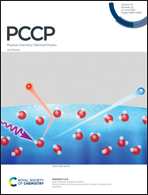Single ion free energy calculation in ASIC1: the importance of the HG loop
Abstract
Acid Sensing Ion Channels (ASICs) are one of the most studied channels of the Epithelial Sodium Channel/Degenerin (ENaC/DEG) superfamily. They are responsible for excitatory responses following acidification of the extracellular medium and are involved in several important physiological roles. The ASIC1 subunit can form a functional homotrimeric channel and its structure is currently the most characterised of the whole ENaC/DEG family. Here we computed the free energy profiles for single ion permeation in two different structures of ASIC1 using both Na+ and Cl− as permeating ions. The first structure is the open structure of the channel from the PDB entry 4NTW, and the second structure is the closed structure with the re-entrant loop which contains the highly conserved ‘HG’ motif form PDB entry 6VTK. Both structures show cation selective free energy profiles, however the profiles of the permeating Na+ differ significantly between the two structures. Indeed, whereas there is only a small energetically favorable (−0.5 kcal mol−1) location for Na+ in the open channel (4NTW) near the end of the pore, we observed a clear ion binding site (−7.8 kcal mol−1) located in between the ‘GAS’ belt and the ‘HG’ loop for the channel containing the re-entrant loop (6VTK). Knowing that the ‘GAS’ motif was determined as the selectivity filter, our results support previous observations while addressing the importance of the ‘HG’ motif for the interactions between the pore and the permeating cations.



 Please wait while we load your content...
Please wait while we load your content...